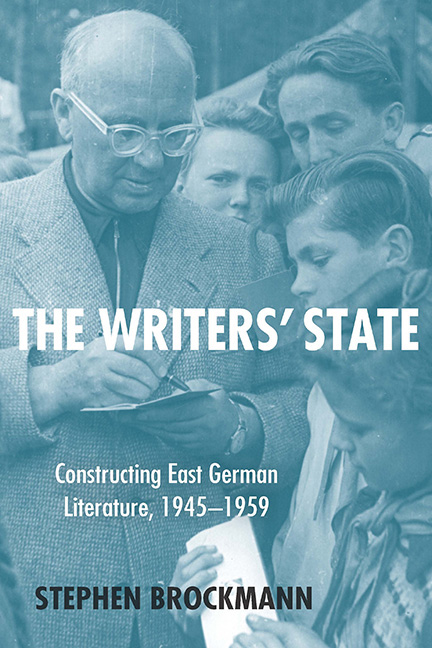Book contents
- Frontmatter
- Dedication
- Contents
- Acknowledgments
- Introduction: Reconstructing East German Literature
- Part I The Absence of State (1945)
- Part II Constructing the State (1949)
- 2 Brecht and the Battle of the Spirits, 1949
- 3 German Culture's Will to Power, 1949–50
- 4 Fascinating Fascists, 1949–50
- Part III Contesting the State (1953)
- Part IV The State Cracks Down (1956)
- Conclusion
- Selected Bibliography
- Index
4 - Fascinating Fascists, 1949–50
from Part II - Constructing the State (1949)
Published online by Cambridge University Press: 05 February 2016
- Frontmatter
- Dedication
- Contents
- Acknowledgments
- Introduction: Reconstructing East German Literature
- Part I The Absence of State (1945)
- Part II Constructing the State (1949)
- 2 Brecht and the Battle of the Spirits, 1949
- 3 German Culture's Will to Power, 1949–50
- 4 Fascinating Fascists, 1949–50
- Part III Contesting the State (1953)
- Part IV The State Cracks Down (1956)
- Conclusion
- Selected Bibliography
- Index
Summary
ANNA SEGHERS's NOVEL Die Toten bleiben jung was published toward the end of 1949. It was quickly greeted by critics as a masterpiece of modern German literature and a foundational literary work for the young GDR. Seghers had worked on the novel in Mexico from 1944 to 1947, and when she returned to Germany in the spring of 1947 she brought the manuscript with her. Die Toten bleiben jung constituted an attempt to tell, by means of fiction, the story of Germany's social and political development from the end of the First World War to the end of the Second World War.
Like Das siebte Kreuz almost a decade earlier, Die Toten bleiben jung featured a multiplicity of characters from various social classes, each with distinct personalities and attitudes. Seghers portrayed Communists and Social Democrats, Nazis and Rhineland industrialists, members of the working class, the aristocracy, peasants, and the petty bourgeoisie. She populated the novel with young and old people, men and women, the physically disabled and the healthy, Jews and non-Jews, Germans and non-Germans—all of the many groups that played a role in the development of German society during the first half of the twentieth century. There were so many characters in the novel that the author included a dramatis personae at the beginning of the book as an aid for readers.
Whereas Das siebte Kreuz had told one overarching story—that of Georg Heisler's successful escape from the fictional Westhofen concentration camp—and thus featured, in spite of its multiplicity of characters, a chief protagonist and unity of action, Die Toten bleiben jung had no obvious main character or unity of action. The plot of Das siebte Kreuz had unfolded over the course of one week, with each of its seven chapters representing a day; Die Toten bleiben jung, by contrast, spanned a period of twenty-five years, and each of its eighteen chapters necessarily covered a considerably longer period than the entirety of Das siebte Kreuz.
Socialist Pessimism
Die Toten bleiben jung also differed from Das siebte Kreuz in another significant respect: it was even more negative than its predecessor. The anti-Nazi intellectual Greta Kuckhoff had complained in 1946 that reading Das siebte Kreuz had left her “completely exhausted,” and she had even charged that the novel pushed its readers toward “a feeling of hopelessness.” Kuckhoff remained in the minority with her criticisms, however.
- Type
- Chapter
- Information
- The Writers' StateConstructing East German Literature, 1945-1959, pp. 139 - 168Publisher: Boydell & BrewerPrint publication year: 2015



